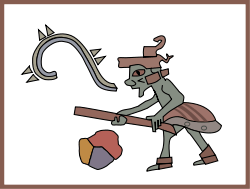Speech scroll

In art history, speech scroll (also called a banderole or phylactery)[1] is an illustrative device denoting speech, song, or, in rarer cases, other types of sound.
Developed independently on two continents, the device was in use by artists within Mesoamerican cultures from as early as 650 BC until after the Spanish conquest in the 16th century, as well as by European painters during the Medieval and Renaissance periods.
While European speech scrolls were drawn as if they were an actual unfurled scroll or strip of parchment, Mesoamerican speech scrolls are merely scroll-shaped, looking much like a question mark.
Pre-Columbian Mesoamerica

Speech scrolls are found throughout Mesoamerica. One of the earliest examples of a Mesoamerican speech scroll was found on an Olmec ceramic cylinder seal dated to approximately 650 BC. Here two lines issue from a bird's mouth followed by glyphs proposed to be "3 Ajaw," a ruler's name.[2]
The murals of the Classic era site of Teotihuacan are filled with speech scrolls, in particular the lively (and unexplained) tableaus found within the Tepantitla compound -- this mural, for example, shows no fewer than 20 speech scrolls.
In Mesoamerica, the speech-scroll is usually oriented with the longest outer edge upward, so that the central element (or "tongue") curves downward as it spirals. Some Mesoamerican speech scrolls are divided lengthwise with each side a different shade.
Glyphs or similar markings rarely appear on the Mesoamerican speech scroll, although "tabs"—small, triangular or square blocks—are sometimes seen along the outer edge. If the speech scroll represents a tongue, then the tabs may represent teeth, but their meaning or message, if any, is not known.[3]

At times, speech scrolls are decorated with devices that describe the tone of the speech:
- In an engraving at the Maya site of Chichen Itza, a ruler's speech scroll takes the form of a serpent.[5]
- A Spaniard's speech scroll in a 16th-century Aztec codex is decorated with feathers to denote "soft, smooth words".[6]
- In another 16th century codex, the Selden Codex, two Mixtec rulers (photo above) are shown insulting two ambassadors through the use of "flint knife" icons attached to the speech scrolls.[7]
As with many native traditions, use of the speech scroll died out in the decades following the Spanish Conquest.
European banderoles


In contrast to the abstract nature of Mesoamerican speech scrolls, Medieval European speech scrolls or banderoles appear as actual scrolls, floating in apparent three-dimensional space (or in actual space in sculpture). They first become common at the start of the Gothic period. Previously, as in Byzantine art, spoken words, if they appeared at all, were usually painted alongside a figure; these are called tituli. However, earlier works using banderoles are the Aachen Gospels of Otto III (c. 975) and the 12th-century English Romanesque Cloisters Cross.[8] The latter work demonstrates the use of banderoles as attributes for Old Testament prophets, to distinguish them from the book-carrying Four Evangelists of the New Testament and other Christian saints, a convention appearing in Italy in the 13th century. It may be seen in the Santa Trinita Maestà by Cimabue, (Uffizi, 1280–90), Duccio's Maestà (1308–11), and other works. The convention had a historical appropriateness, as the Old Testament was originally written on scrolls, whereas nearly all surviving New Testament manuscripts are codices (like modern books). They may also be used for the words of angels, especially Gabriel's greeting to Mary in Annunciation scenes.[9] During the 14th century, quotations in banderoles increasingly allowed artists to include more complex ideas in their works, though for the moment usually in Latin, thus greatly restricting the audience that could follow them.[10]
Unlike Mesoamerican speech scrolls, European speech scrolls usually contain the spoken words, much like a modern-day speech balloon. The majority of these are in religious works and contain Biblical quotations from the figure depicted – Old Testament prophets for example, were often shown with an appropriate quotation from their work. Because the words are usually religious in nature, the speech scroll is often written in Latin even when appearing in woodcut illustrations for books written in the vernacular.[11] This would also enable the illustration to be used in editions in other languages.
European speech scrolls may at times be seen in secular works as well and may also contain the name of a person to identify them. On carved figures the words would usually be painted on the scroll and have since worn away. In some Late Gothic and Renaissance works, and in architectural decoration, very elaborate empty banderoles seem to be for decorative purposes only.
The European speech scroll fell out of favor largely due to an increasing interest in realism in painting; the halo had a similar decline.
See also
| Wikimedia Commons has media related to Speech scrolls. |
- Speech balloon
- Banderole - a streamer or pennant
Notes
References
- Boone, Elizabeth (1994) Writing Without Words: Alternative Literacies in Mesoamerica and the Andes, Duke University Press.
- Coggins, Clement Chase (1992) "Pure Language & Lapidary Prose" in New Theories on the Ancient Maya, Elin C. Danien and Robert J. Sharer, Eds., University of Pennsylvania Museum.
- famsi. "John Pohl's - Ancient Books - Mixtec Group Codices - Codex Selden". FAMSI. Retrieved 16 July 2016.
- Hilmo, Maidie (2004) Medieval Images, Icons, and Chaucer Illustrated English Literary Texts: From Ruthwell Cross to the Ellesmere Chaucer, Ashgate Publishing.
- Holt, Dennis "About the Endangered Language Fund Logo", accessed November 2007.
- Kantorowicz, Ernst Hartwig (1997). The King's Two Bodies: A Study in Mediaeval Political Theology. Princeton University Press. p. 67. ISBN 0-691-01704-2.
- Ladis, Andrew & Maginnis, Hayden B. J. (1997), Painting in the Age of Giotto: A Historical Reevaluation, Penn State Press, ISBN 0-271-02091-1, ISBN 978-0-271-02091-4, google books
- Petersen, Robert S. (2011). Comics, Manga, and Graphic Novels: A History of Graphic Narratives. ABC-CLIO. p. 19. ISBN 978-0-313-36330-6.
- Pohl, Mary; Pope, Kevin O.; Nagy, Christopher von ;(2002) "Olmec Origins of Mesoamerican Writing, in Science, vol. 298, pp. 1984–1987.
- Wishart Trevor (1966) On Sonic Art Routledge.